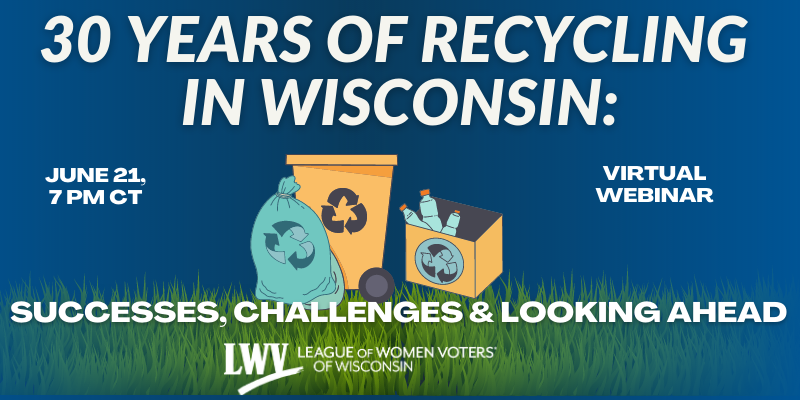
Watch below!
On Wednesday, June 21, 2023 the LWVWI offered the Webinar, 30 Years of Recycling in Wisconsin: Successes, Challenges and Looking Ahead. Presenters were Jennifer Semrau (Waste Reduction & Diversion Coordinator, Waste & Materials Management Program, WDNR), Lynn Morgan (Public Affairs Manager, WM) and Meleesa Johnson (Retired Director, Marathon County Solid Waste Management Program).
They provided great information about what is in the current waste stream, which is the term to describe the end of the life cycle of products we buy, use and discard. They also covered what we are recycling—cardboard, other paper, steel, aluminum, glass and plastic containers #1 through 7.
Some takeaways:
-
735,000 tons were recycled by Wisconsin municipalities in 2021.
-
19% of landfilled materials (valued at $87 million) could have been recycled.
-
Food waste is the largest component in the waste stream. About 6 to 8% of greenhouse gas emissions are attributed to food waste.
-
Recyclable material needs to be redefined as solid waste recovered from the waste stream that can be processed into the production of new products.
Johnson and Morgan advocated for moving from weight-based recycling goals to goals that consider environmental and economic impacts.
Weight-based goals emphasize quantity over quality. This contributes to increased contamination, which is about 18% of incoming material. Unrecyclable materials are expensive for processors to remove and ultimately, must be landfilled. Transporting unrecyclable materials to landfill, adds transport fuel, greenhouse gas emissions and costs for haulers and processors.
In measuring recycling goals, environmental benefits, such as reducing greenhouse gas, should be our priority. Markets are looking for clean recycling materials. ‘Wishful’ recycling by consumers undercuts the stability of recycling in Wisconsin. Because avoided waste doesn’t count toward goals, weight-based goals undercut waste reduction strategies.
Speakers Include:
 LYNN MORGAN, PUBLIC AFFAIRS MANAGER, WM |
 JENNIFER SEMRAU, WASTE REDUCTION & DIVERSION COORDINATOR, WASTE & MATERIALS MANAGEMENT PROGRAM, WDNR, OSHKOSH SERVICE CENTER |
 MELEESA JOHNSON, RECENTLY RETIRED DIRECTOR, MARATHON COUNTY SOLID WASTE MANAGEMENT PROGRAM |